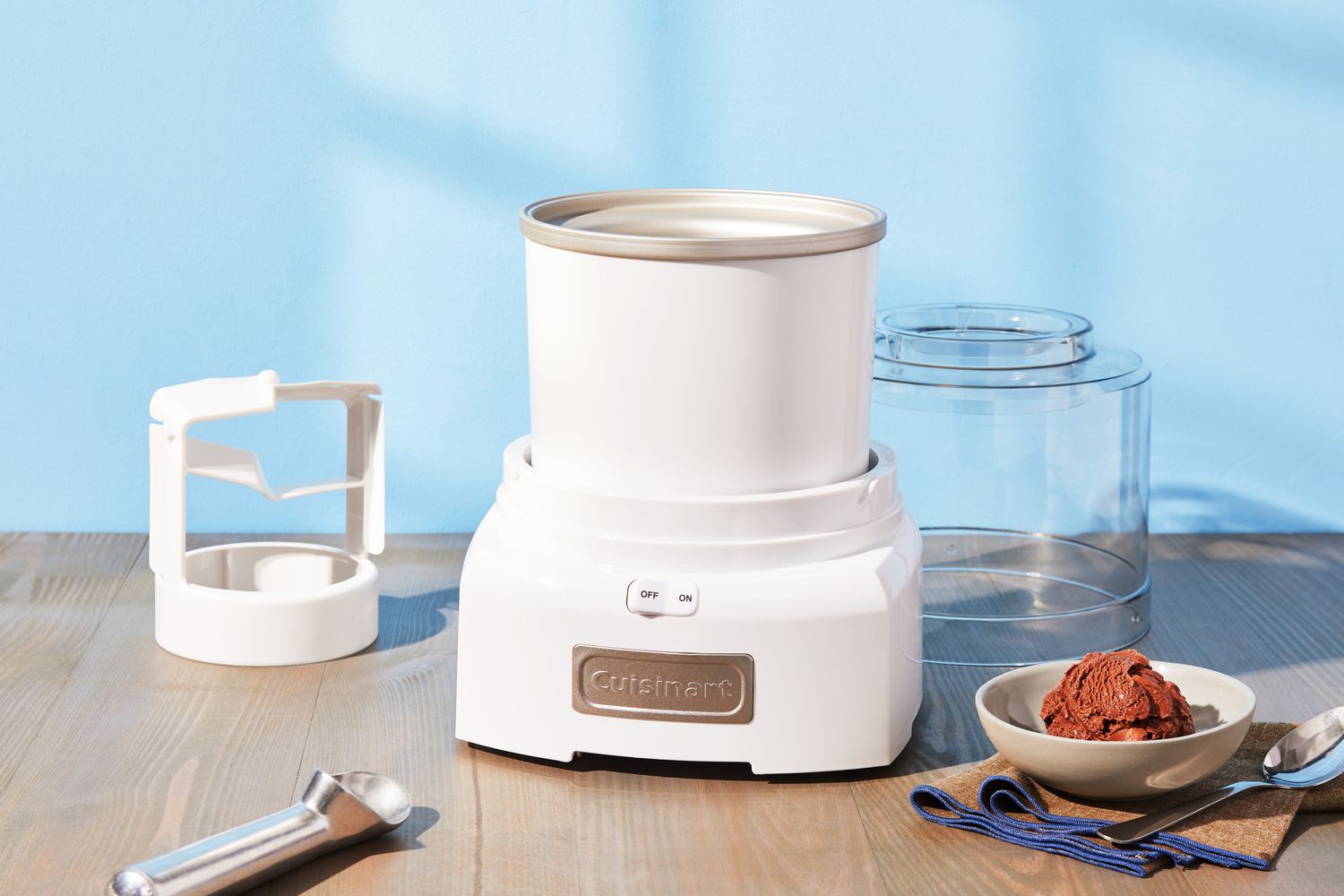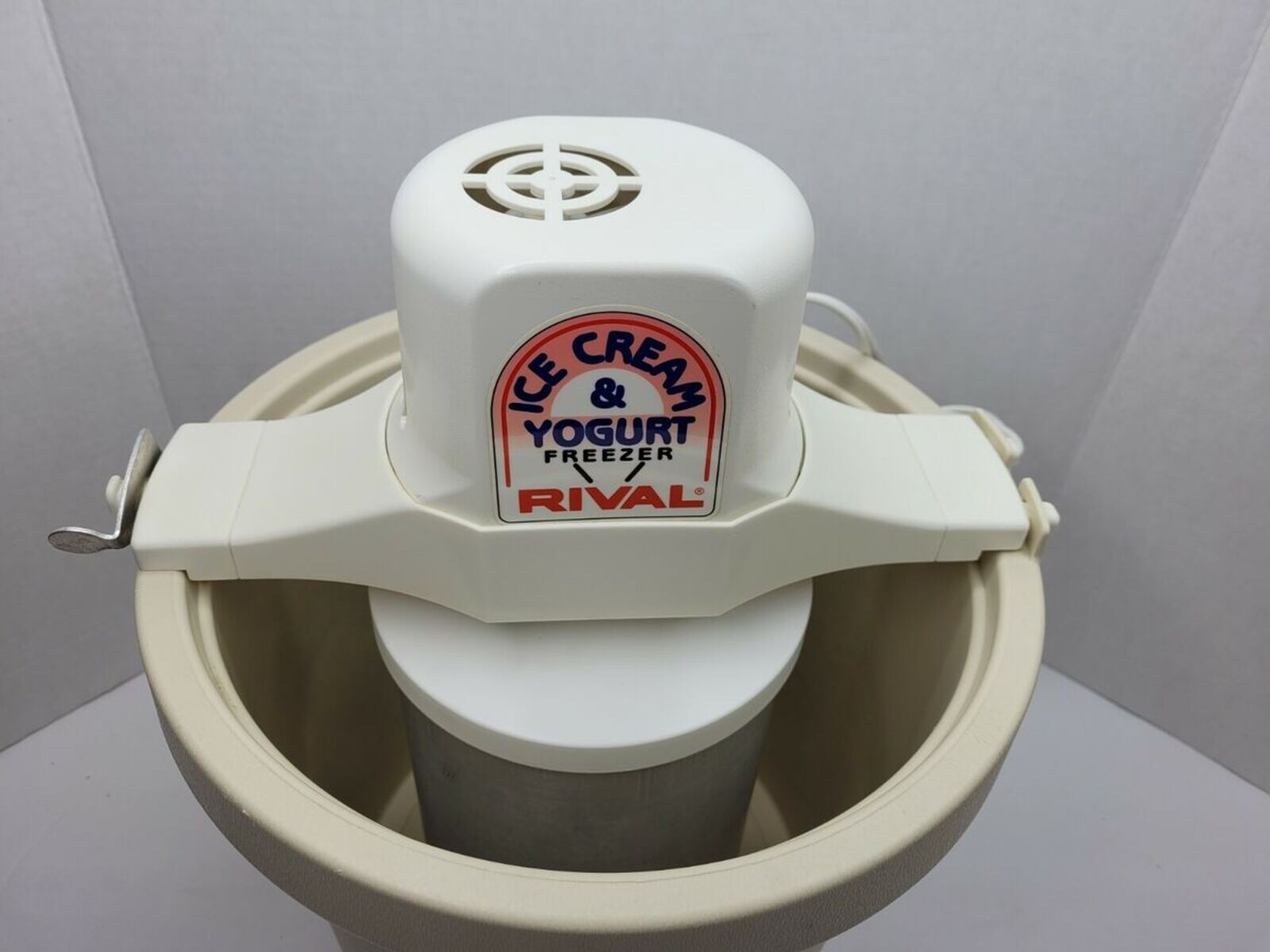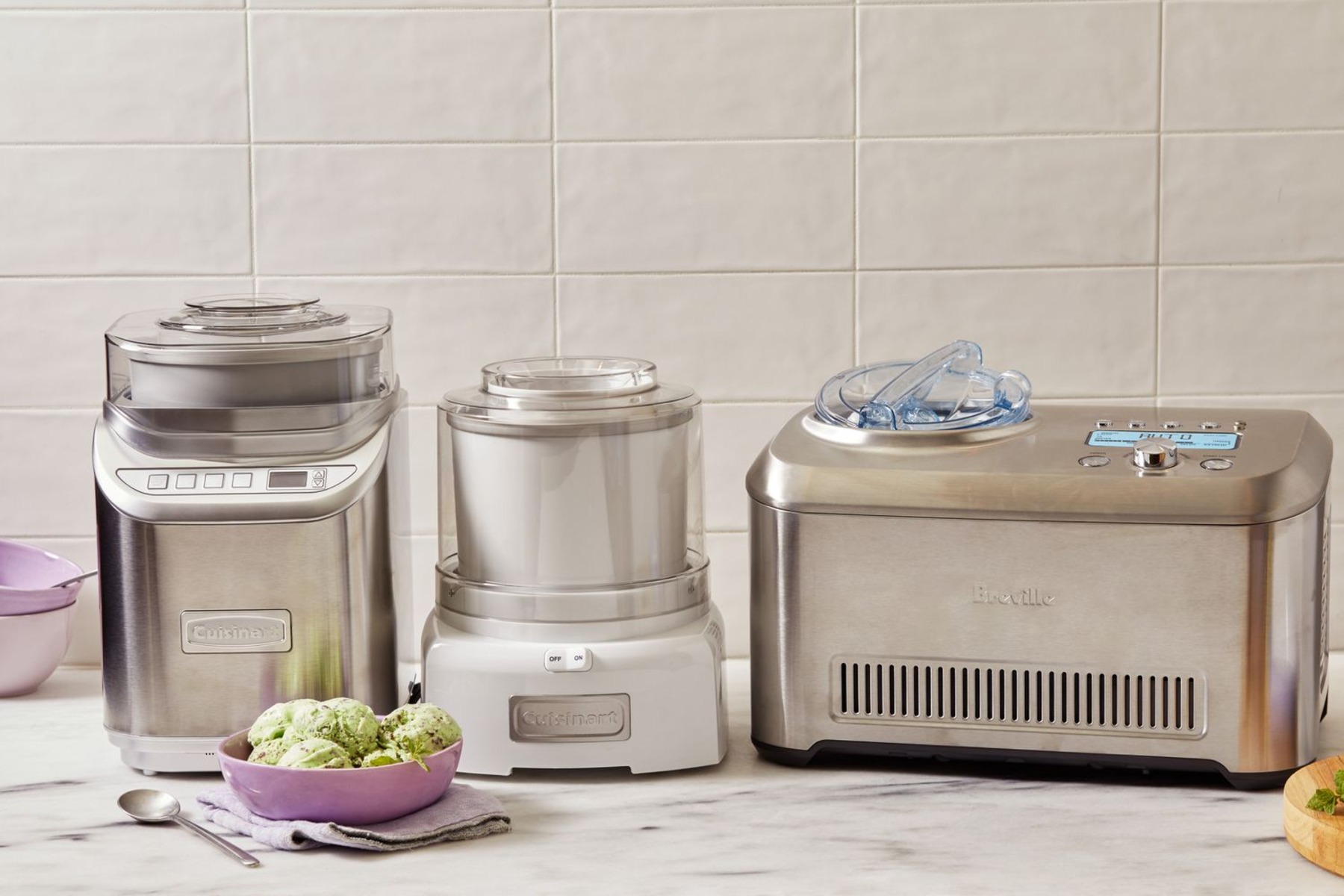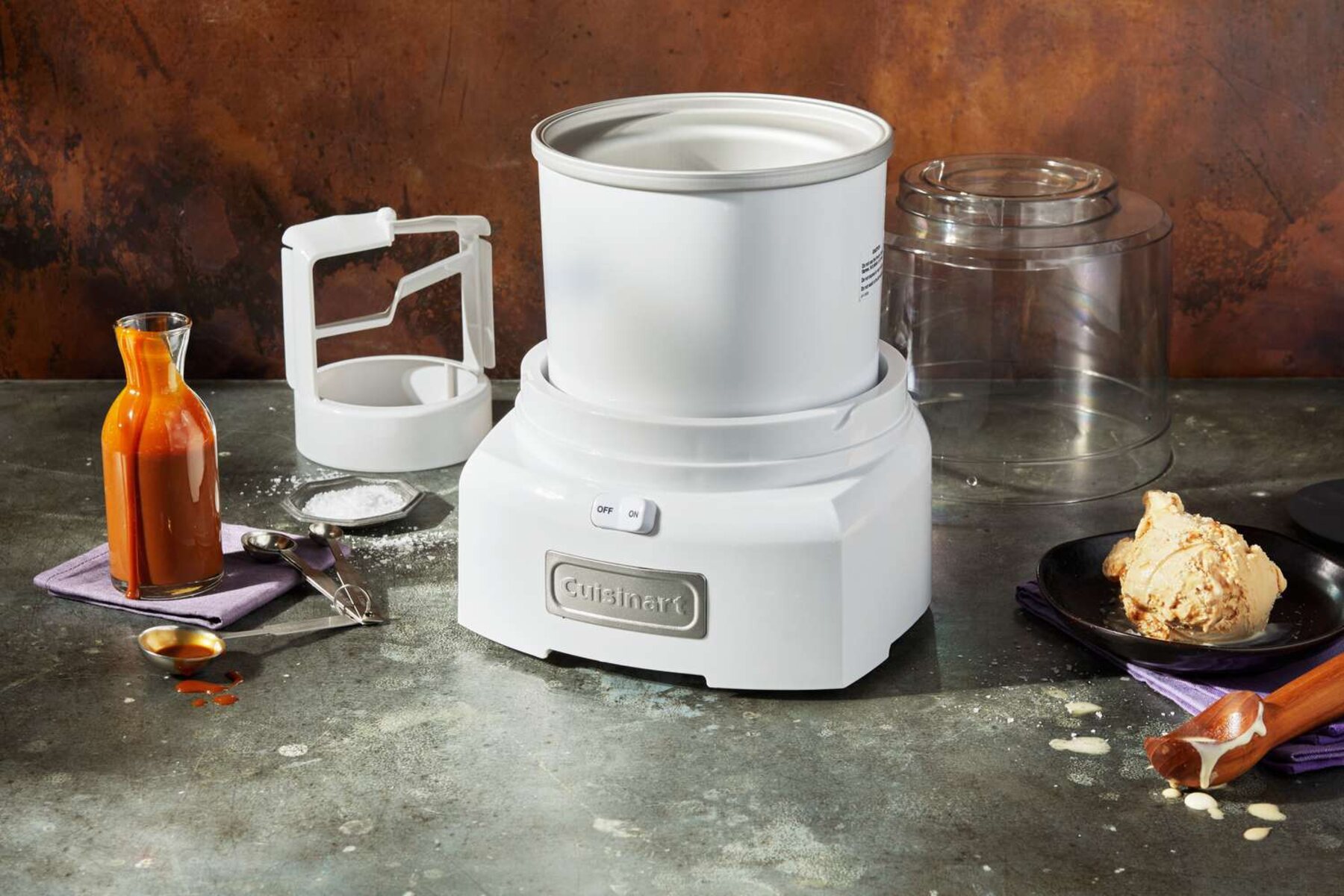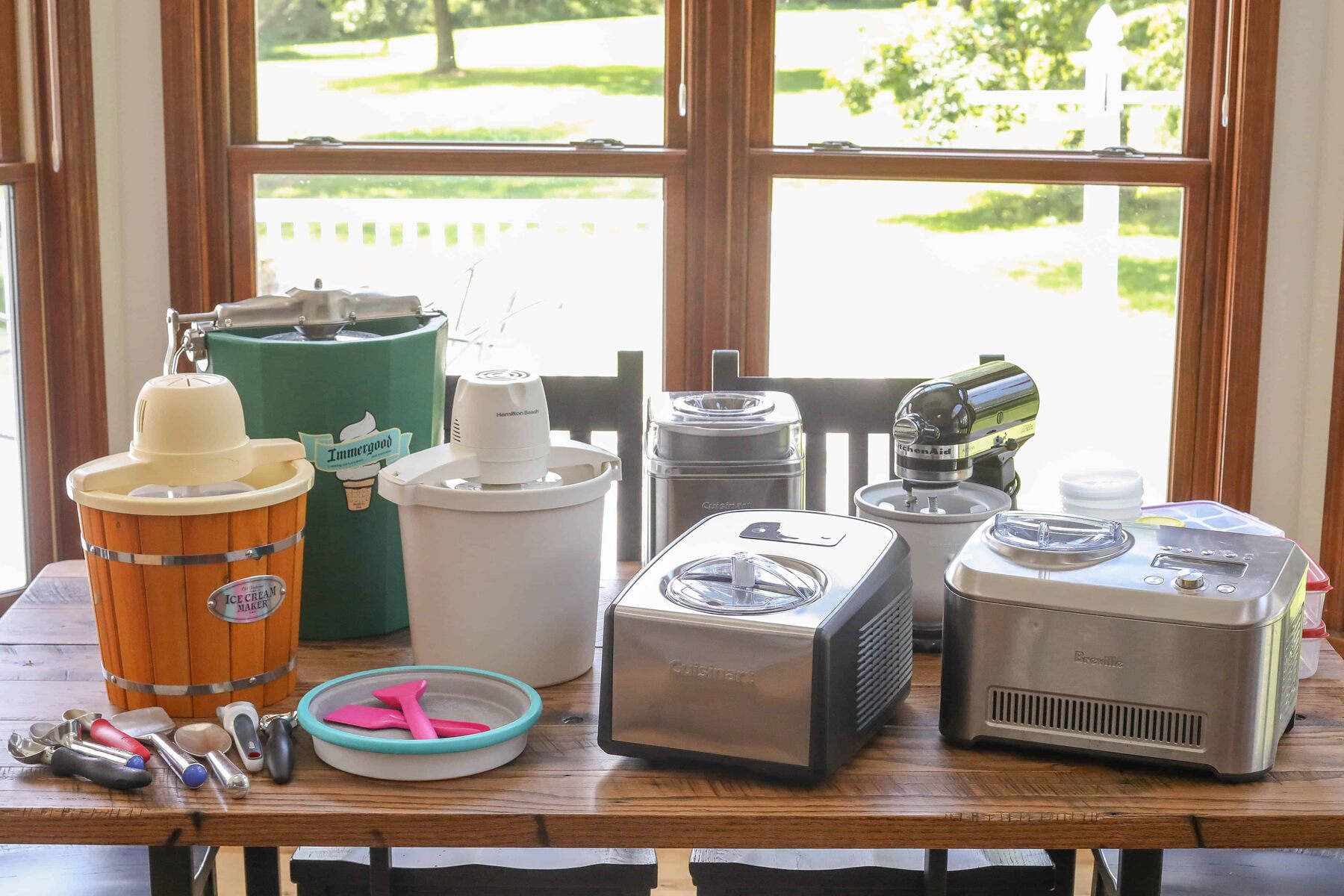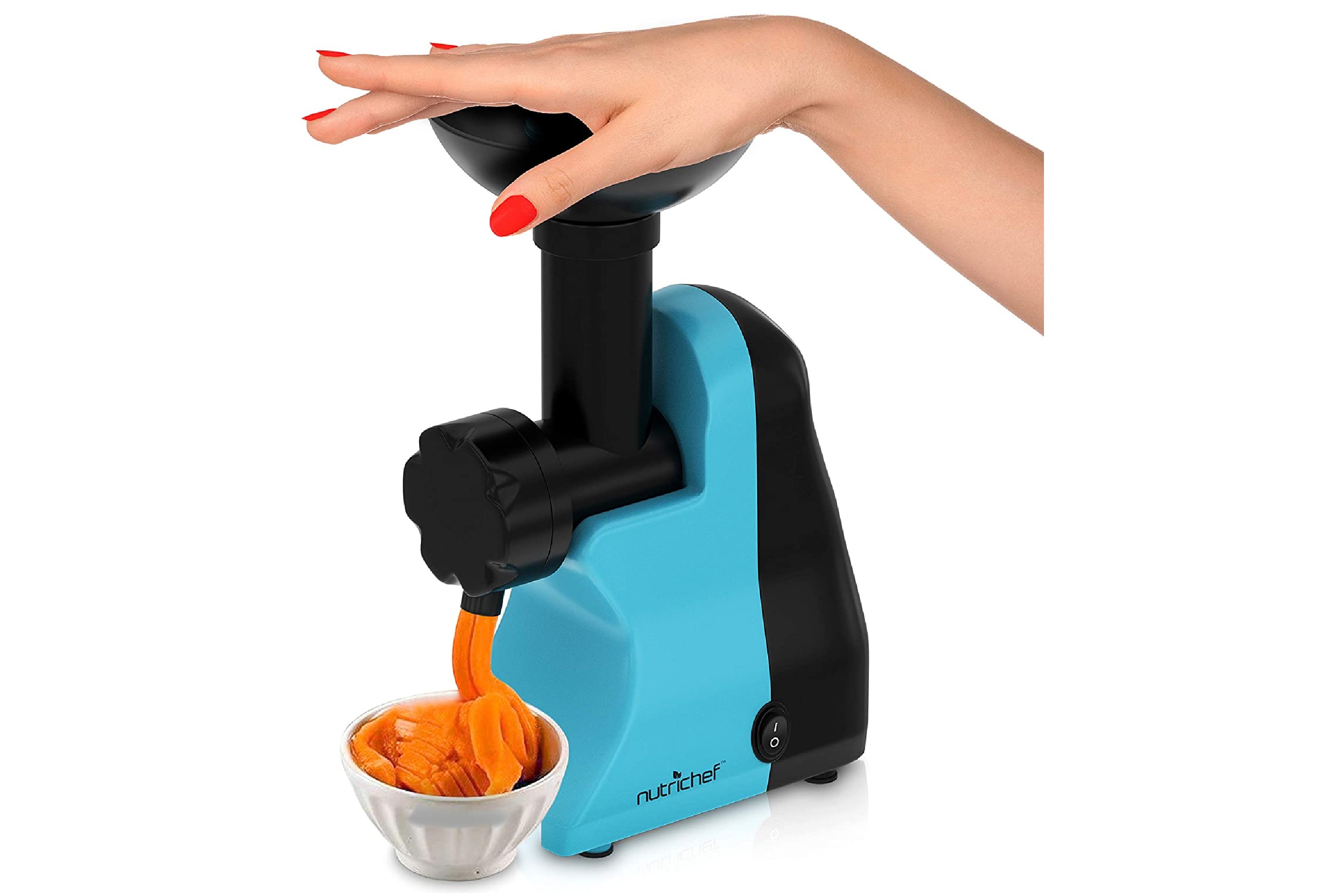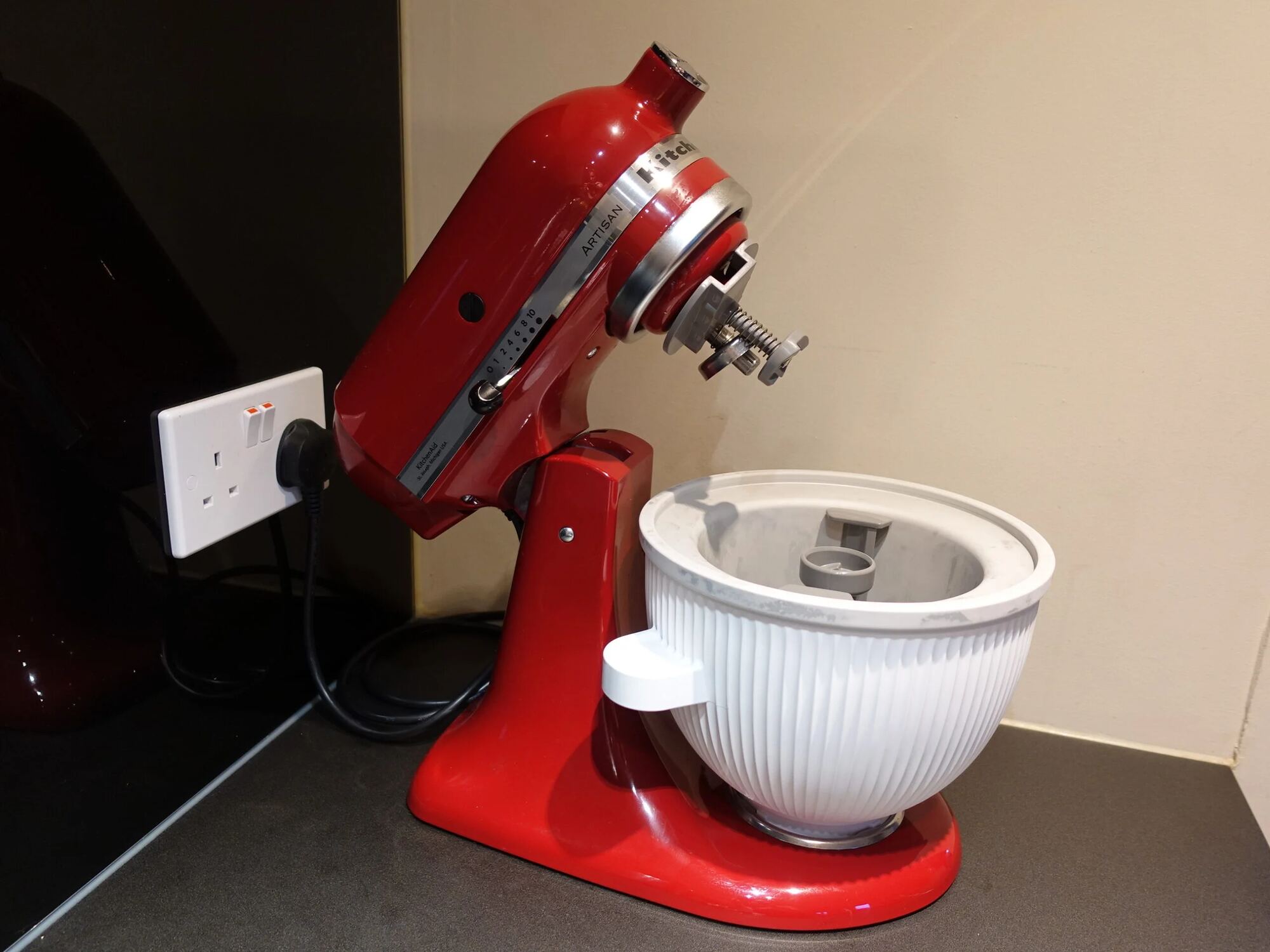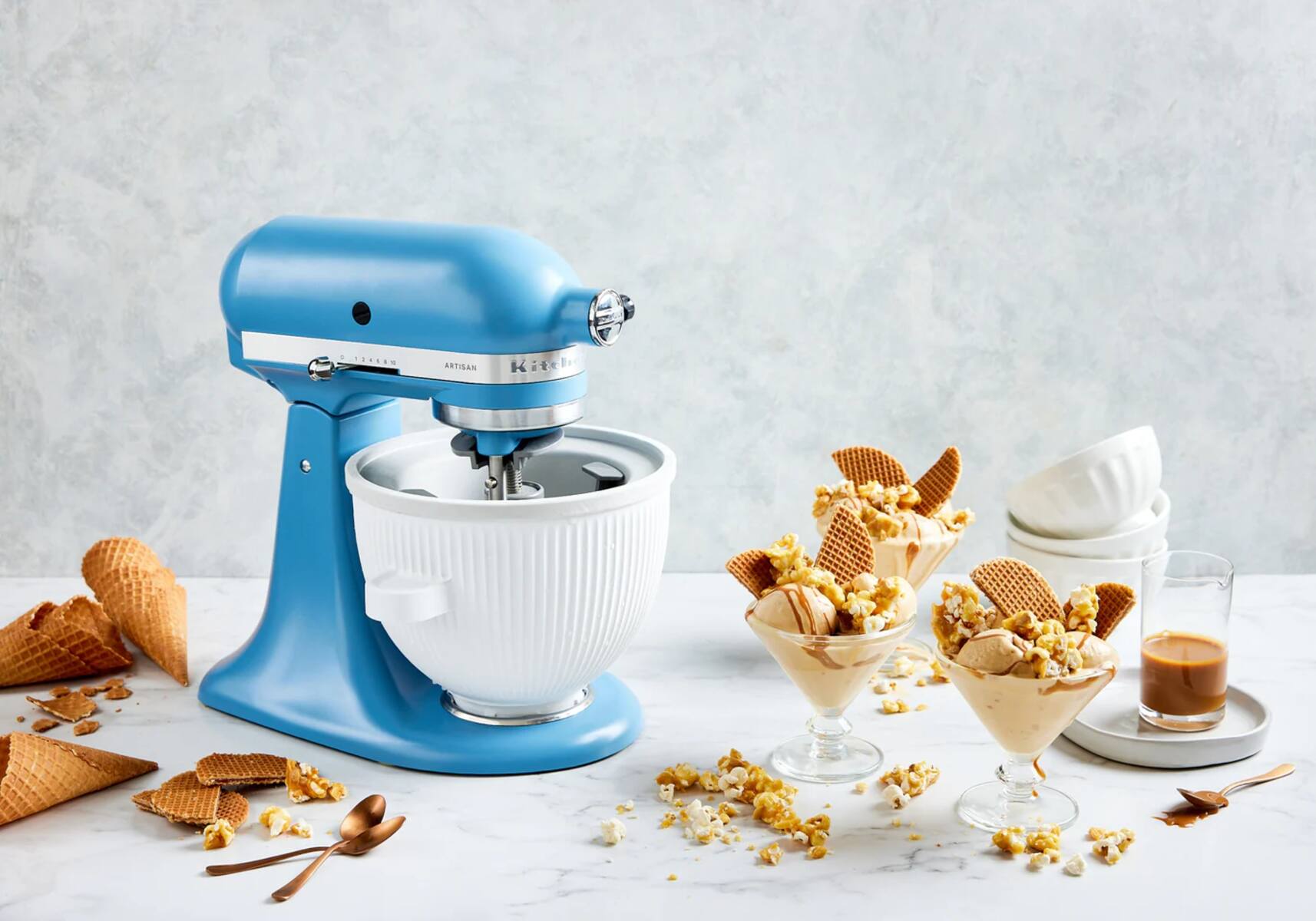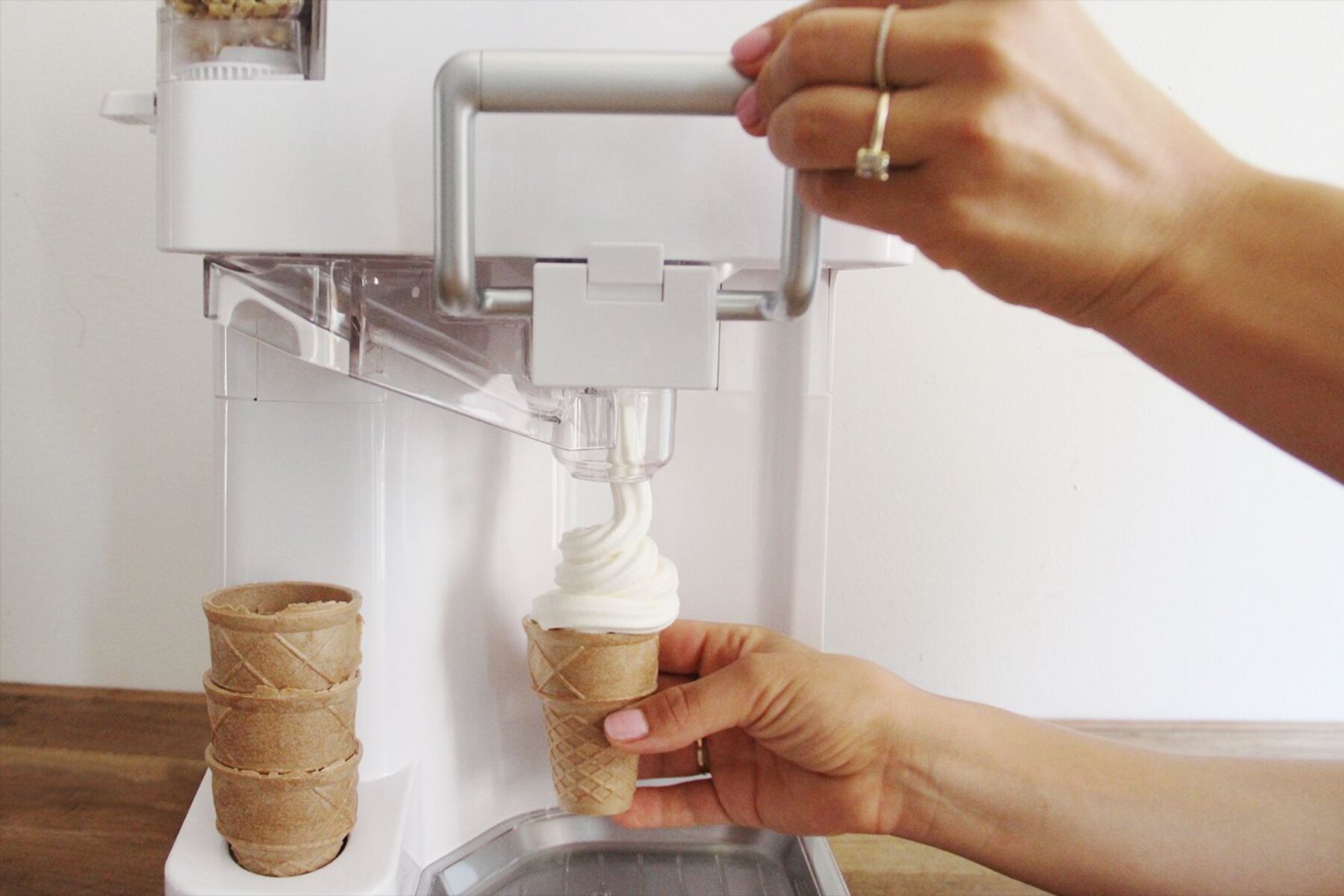Introduction
Welcome to the delightful world of ice cream makers! Whether you’re an ice cream enthusiast or simply someone who enjoys the occasional frozen treat, having an ice cream maker at home can be a game-changer. With just a few ingredients and a dash of creativity, you can whip up delicious and customized ice cream flavors right in your kitchen.
An ice cream maker is a kitchen appliance specifically designed to make ice cream. It takes the hassle out of the traditional hand-cranking method and automates the churning process to produce smooth and creamy ice cream.
There are different types of ice cream makers available on the market, ranging from manual to electric options. Each type has its own unique features and benefits. In this article, we will explore the various types of ice cream makers, their components, and popular brands that offer these appliances.
When it comes to the appearance of an ice cream maker, you’ll find a variety of sizes and designs to choose from. Some are compact and space-saving, while others are more visually striking with sleek, modern aesthetics. We’ll dive into the different sizes and designs to help you find the perfect ice cream maker for your needs and kitchen space.
Popular brands such as Cuisinart, KitchenAid, and Breville dominate the ice cream maker market, offering a wide range of models with various features and capacities. We’ll highlight these brands and discuss their reputation and customer reviews, giving you a better understanding of which ice cream makers are worth considering.
Furthermore, we’ll guide you through the process of using an ice cream maker. From preparing the ice cream base to churning and freezing, we’ll provide step-by-step instructions to ensure your homemade ice cream turns out perfectly every time.
Last but not least, we’ll share some valuable tips on cleaning and maintaining your ice cream maker. This will help you prolong the lifespan of your appliance and keep it running smoothly for years of ice cream-making enjoyment.
Now, let’s embark on a delightful journey into the world of ice cream makers, exploring the ins and outs of these versatile appliances!
What is an Ice Cream Maker?
An ice cream maker is a kitchen appliance that allows you to create your own delicious ice cream at home. It automates the churning process, taking away the manual effort required to make ice cream by hand. Ice cream makers come in various types, including manual, electric, and compressor-based options.
A manual ice cream maker consists of a canister or bowl that needs to be placed in the freezer prior to use. The canister is filled with the ice cream mixture, and a paddle or dasher is inserted. The canister is then placed inside the outer bucket, which is filled with ice and rock salt or a freezing mixture. By manually turning the crank or paddle, the mixture is continually agitated while the freezing mixture absorbs the heat, resulting in smooth and creamy ice cream.
Electric ice cream makers, on the other hand, have a built-in motor that automates the churning process. These models typically feature a removable freezer bowl that needs to be pre-frozen before use. The ice cream mixture is poured into the freezer bowl, and the motor turns the dasher, churning the mixture as it freezes. Electric ice cream makers are convenient and require less effort than manual models.
Compressor-based ice cream makers are the most advanced type available. They have a built-in compressor that freezes the ice cream mixture as it churns. These models don’t require pre-freezing of any parts, making them incredibly convenient. You can simply add the mixture and start the machine, and it will churn and freeze the ice cream to perfection. Compressor-based ice cream makers are ideal for those who make ice cream frequently or have large batches to process.
Regardless of the type, ice cream makers allow you to experiment with different flavors, textures, and mix-ins. You have complete control over the ingredients, including the quality of the dairy, the sweetness levels, and the addition of flavors like chocolate, fruits, or nuts. With an ice cream maker, you can unleash your creativity and customize your frozen treats to suit your preferences.
Ice cream makers are not limited to just making ice cream. Many models also have the ability to make other frozen desserts like sorbets, gelato, frozen yogurts, and even milkshakes. This versatility ensures that you can enjoy a wide variety of frozen desserts using a single appliance.
Now that you have a better understanding of what an ice cream maker is and the various types available, let’s explore the different components and features that make up these delightful appliances.
Different Types of Ice Cream Makers
Ice cream makers come in various types, each with its own unique features, benefits, and methods of operation. Understanding the different types will help you choose the one that best suits your needs and preferences.
1. Manual Ice Cream Makers: Manual ice cream makers require physical effort to churn the ice cream mixture. They typically consist of a canister or bowl that needs to be pre-frozen before use. A paddle or dasher is inserted into the canister, and the mixture is continuously agitated by manually turning a crank or paddle. These models are simple to use and often more affordable, but they do require more effort and time compared to electric or compressor-based models.
2. Electric Ice Cream Makers: Electric ice cream makers are powered by a motor that automates the churning process. They commonly come with a removable freezer bowl that needs to be pre-frozen. The ice cream mixture is poured into the freezer bowl, and the motor turns the dasher to churn and freeze the mixture. Electric ice cream makers are generally more convenient and easier to use than manual models. They eliminate the need for hand-cranking and provide consistent results with less effort.
3. Compressor-Based Ice Cream Makers: Compressor-based ice cream makers are the most advanced and convenient type. They feature a built-in compressor, eliminating the need for pre-freezing any parts. These models can both churn and freeze the ice cream simultaneously. The ice cream mixture is added directly into the machine, and the compressor cools it down as the dasher churns the mixture. This allows for the continuous preparation of multiple batches or different flavors without the need for waiting or swapping freezer bowls. Compressor-based ice cream makers are perfect for those who frequently make ice cream or have large quantities to produce.
4. Soft Serve Ice Cream Machines: Soft serve ice cream machines are popular in commercial settings but can also be found in home versions. They use a built-in freezing system and are capable of producing smooth and creamy soft serve ice cream. These machines often have the ability to dispense ice cream directly into cones or bowls, making them ideal for parties or gatherings. Soft serve machines typically require a higher upfront investment but offer the convenience of serving soft serve ice cream on demand.
5. Ice Cream Ball Makers: Ice cream ball makers are a fun and unique type of ice cream maker that doubles as a recreational activity. These portable devices consist of two nesting chambers, one containing the ice cream mixture and the other filled with ice and rock salt. The user rolls, shakes, or tosses the ball, allowing the mixture to churn and freeze inside. This type of ice cream maker is great for camping trips, picnics, or any outdoor adventure.
Now that you have an understanding of the different types of ice cream makers available, let’s explore the components that make up these delightful appliances.
Components of an Ice Cream Maker
An ice cream maker consists of several key components that work together to create smooth and creamy ice cream. Understanding these components will help you have a better grasp of how an ice cream maker functions and how to make the most out of its capabilities.
1. Freezer Canister or Bowl: The freezer canister or bowl is a crucial component in ice cream makers. In manual and electric models, this container needs to be pre-frozen before use. It is typically made of stainless steel or a durable plastic material and is designed to hold the ice cream mixture while it freezes and churns. The freezer canister or bowl should be completely frozen before adding the ice cream mixture to ensure proper freezing and consistency.
2. Dasher or Paddle: The dasher or paddle is the part that mixes and churns the ice cream mixture within the canister or bowl. It comes in various designs, often with sturdy blades or a spiral shape, to effectively agitate the mixture. The dasher or paddle ensures even distribution of the cold temperature, incorporating air into the mixture and preventing ice crystals from forming, resulting in a smooth and creamy texture.
3. Motor: Electric and compressor-based ice cream makers have a built-in motor that powers the churning of the ice cream mixture. The motor rotates the dasher or paddle at a consistent speed, ensuring a thorough and even mixing process. The motor in electric ice cream makers is designed to operate quietly and efficiently, allowing you to enjoy the ice cream-making process without disturbance.
4. Lid: The lid is an essential component that covers the top of the ice cream maker. It prevents any external contaminants from entering the ice cream mixture during the churning process. The lid may come with a small opening or chute, allowing you to add mix-ins or ingredients as the ice cream churns. Some lids may also have a transparent window, allowing you to monitor the progress of the ice cream without removing the lid.
5. Control Panel or Timer: Electric and compressor-based ice cream makers often feature a control panel or timer that allows you to set the desired churning time or adjust certain settings. The control panel may include buttons for power, start/stop, and speed control, providing you with more control over the ice cream-making process. Some models also have pre-programmed settings for specific types of frozen desserts, making it easier to achieve the perfect consistency.
6. Outer Bucket or Casing: In manual ice cream makers, an outer bucket or casing is used to hold the ice and rock salt mixture that surrounds the freezer canister, creating a cold environment for freezing the ice cream. This bucket or casing is made of insulating material, often double-walled, to keep the ice from melting too quickly during the churning process.
By familiarizing yourself with these components, you’ll have a better understanding of how an ice cream maker works and how to properly assemble and operate it. Now let’s move on to explore the size and design options available in ice cream makers.
Size and Design
Ice cream makers come in a variety of sizes and designs to cater to different needs and kitchen spaces. Understanding the different size options and design features will help you choose an ice cream maker that fits well into your lifestyle and aesthetics.
Size: Ice cream makers are available in various capacities, ranging from small personal-sized units to larger models suitable for families or commercial use. Personal-sized ice cream makers typically have a capacity of around 1 to 2 quarts, making them perfect for individuals or small households. They are compact and space-saving, ideal for those with limited counter or storage space.
Family-sized ice cream makers have larger capacities, typically ranging from 4 to 6 quarts, allowing you to make larger quantities of ice cream. These models are suitable for families or those who enjoy hosting parties or gatherings. While they may take up more space on your countertop, they offer the advantage of producing more ice cream in a single batch.
Commercial-sized ice cream makers are designed for high-volume production and are commonly used in ice cream parlors or businesses. They have significantly larger capacities and robust construction to handle continuous use. If you’re running a business or plan to make considerable amounts of ice cream, a commercial-sized ice cream maker may be the ideal choice.
Design: Ice cream makers come in a range of designs to suit different aesthetic preferences. Some models have a classic and timeless design, featuring a stainless steel or retro-inspired exterior. These designs often have a nostalgic appeal and can complement various kitchen styles.
Other ice cream makers have a modern and sleek design, incorporating elements like stainless steel accents, touch controls, and LED displays. These models offer a contemporary look that fits well into modern kitchen settings. They often come with additional features such as multiple program settings or built-in timers.
Along with the overall design, ice cream makers may also have specific design features that enhance functionality and ease of use. These can include removable freezer bowls for easy cleaning, transparent lids for monitoring the ice cream’s progress, and ergonomic handles for convenient handling.
When choosing an ice cream maker based on size and design, consider the space available in your kitchen, the quantity of ice cream you wish to make, and your personal style preferences. Finding the right balance between capacity and aesthetics will ensure that your ice cream maker not only delivers delicious frozen treats but also complements your kitchen décor.
Now that we’ve explored the size and design options, let’s move on to discuss some popular brands that offer reliable and high-quality ice cream makers.
Popular Brands of Ice Cream Makers
When it comes to buying an ice cream maker, there are several reputable brands known for their quality, performance, and customer satisfaction. Let’s take a look at some popular ice cream maker brands that are worth considering.
1. Cuisinart: Cuisinart is a well-known and trusted brand in the kitchen appliance industry. They offer a wide range of ice cream makers, from compact models to larger capacity machines. Cuisinart ice cream makers are known for their user-friendly features, durable construction, and consistent performance. They often come with removable freezer bowls, intuitive control panels, and versatile functionalities, allowing you to create various frozen desserts.
2. KitchenAid: KitchenAid is a brand synonymous with quality and craftsmanship. While they are primarily known for their stand mixers, their ice cream maker attachments have gained popularity among home chefs. These attachments are compatible with KitchenAid stand mixers and provide a convenient way to transform your mixer into an ice cream maker. KitchenAid ice cream maker attachments are known for their durability, reliability, and the ability to produce rich and creamy frozen treats.
3. Breville: Breville is a brand recognized for its high-end and innovative kitchen appliances. Their ice cream makers combine sleek design with advanced features to deliver exceptional performance. Breville ice cream makers often come with built-in compressors, eliminating the need for pre-freezing, and ensuring quick and efficient ice cream making. They are known for their precision control, allowing you to achieve the perfect consistency and texture of your ice cream or other frozen desserts.
4. Hamilton Beach: Hamilton Beach offers a range of affordable and reliable ice cream makers that are perfect for those on a budget. Their models come in various sizes and capacities, allowing you to choose the one that suits your needs. Hamilton Beach ice cream makers are known for their simplicity and ease of use. They often have straightforward controls, removable freezer bowls, and intuitive designs that make the ice cream-making process hassle-free.
5. Nostalgia: If you’re looking for a touch of nostalgia, the aptly named Nostalgia brand offers ice cream makers with a retro-inspired design. These models evoke a vintage charm while incorporating modern conveniences. Nostalgia ice cream makers often have unique features like a built-in candy crusher or the ability to make soft serve ice cream. They are known for their eye-catching aesthetics and the ability to create fun and delicious frozen treats.
These are just a few examples of popular brands in the ice cream maker market. Before making a purchase, it’s always a good idea to read customer reviews, compare features, and consider your specific needs and preferences to ensure you choose an ice cream maker that suits you best.
Now that we’ve explored some popular brands, let’s move on to discover how to use an ice cream maker to create your own homemade frozen delights.
How to Use an Ice Cream Maker
Using an ice cream maker is relatively straightforward, and it allows you to create delicious homemade ice cream in just a few simple steps. Whether you have a manual, electric, or compressor-based ice cream maker, the following general instructions will guide you through the process.
1. Prepare the Ice Cream Mixture: Start by preparing your ice cream mixture according to your desired recipe. This typically involves combining ingredients like cream, milk, sugar, and flavorings. You can follow a recipe from a cookbook or get creative and experiment with your own flavors.
2. Pre-Freeze the Freezer Bowl: If you have a manual or electric ice cream maker, make sure to pre-freeze the freezer bowl as per the manufacturer’s instructions. This usually involves placing the bowl in the freezer for a designated amount of time, typically between 6 to 24 hours. Ensure that the bowl is completely frozen before continuing to the next step.
3. Assemble the Ice Cream Maker: Set up your ice cream maker by attaching the dasher or paddle according to the manufacturer’s instructions. Make sure it is securely in place to ensure proper mixing and churning during the freezing process. If applicable, attach the lid as well.
4. Start the Churning Process: Pour the prepared ice cream mixture into the freezer bowl of the ice cream maker. Turn on the machine, and let it begin churning. The motor will rotate the dasher or paddle, ensuring the mixture is continuously mixed while freezing. The churning process helps incorporate air and prevents the formation of ice crystals, resulting in a creamy consistency.
5. Monitor and Add Mix-Ins: As the ice cream churns, you can add mix-ins such as chocolate chips, nuts, or fruit pieces through the opening in the lid, if available. Add these mix-ins toward the end of the churning process to ensure even distribution throughout the ice cream mixture.
6. Check Doneness: Once the ice cream reaches a soft-serve consistency, it is typically done. You can check the consistency by using a spoon or spatula to scoop a small portion of the mixture. If it holds its shape and is smooth and creamy, it’s ready. Keep in mind that the precise time for achieving the desired consistency will vary depending on the specific ice cream maker and recipe used.
7. Transfer and Freeze: After achieving the desired consistency, transfer the churned ice cream into an airtight container. Place the container in the freezer to allow the ice cream to firm up further. This step is essential for ensuring the ice cream reaches a scoopable texture.
8. Enjoy: Once the ice cream has fully frozen, it is ready to be enjoyed. Serve it in bowls, cones, or use it to create sundaes, milkshakes, or other icy treats. Experiment with different toppings and sauces to enhance the flavor experience.
Remember to refer to the specific instructions provided by the manufacturer of your ice cream maker to ensure you are following the correct steps for your particular model. With practice and experimentation, you can perfect your homemade ice cream recipes and create frozen delights that rival your favorite ice cream shop.
Now that you know how to use an ice cream maker, let’s move on to important tips for cleaning and maintaining your appliance.
Tips for Cleaning and Maintaining an Ice Cream Maker
Proper cleaning and maintenance of your ice cream maker will ensure its longevity and optimal performance. Here are some important tips to keep in mind:
1. Read the Instructions: Always refer to the instruction manual provided by the manufacturer for specific cleaning and maintenance guidelines. Different ice cream makers may have varying requirements, so it’s important to follow the instructions specific to your model.
2. Unplug and Disassemble: Before cleaning your ice cream maker, make sure it is unplugged and cooled down. Disassemble any removable parts such as the freezer bowl, dasher, or lid, as instructed. This will make it easier to clean each component separately.
3. Hand Wash: Most parts of an ice cream maker, such as the freezer bowl, dasher, and lid, are typically not dishwasher-safe. It’s best to hand wash these components with warm soapy water. Pay attention to any nooks, crevices, or hard-to-reach areas that may have accumulated residue. Use a soft brush or sponge to gently scrub away any stubborn residue.
4. Dry Thoroughly: After washing, ensure that all parts are thoroughly dried before reassembling or storing them. Moisture can lead to the growth of mold or mildew, so take care to dry each component completely. Towel-drying is effective, or you can let the parts air dry on a dish rack or clean surface.
5. Clean the Exterior: Wipe down the exterior of the ice cream maker with a damp cloth or sponge to remove any spills, splatters, or residue. Avoid using abrasive cleaners or harsh chemicals, as they can damage the surface of the appliance. Dry the exterior thoroughly to prevent any water damage.
6. Store Properly: When not in use, store your ice cream maker in a cool and dry place to prevent any moisture or dust from accumulating. Consider keeping the original packaging or using a protective cover to shield the appliance from potential damage.
7. Regular Maintenance: Regularly check your ice cream maker for any signs of wear and tear or loose components. If you notice any issues, contact the manufacturer for guidance or professional assistance. Following an appropriate maintenance schedule will help ensure your ice cream maker continues to work efficiently.
8. Use Good Quality Ingredients: Another important aspect of maintaining your ice cream maker is to use high-quality ingredients. Choose fresh and premium ingredients, especially when it comes to dairy products. Low-quality ingredients can leave residue or affect the taste and texture of your ice cream. It’s also a good idea to clean the ice cream maker immediately after each use to prevent any stubborn residue from setting in.
By following these cleaning and maintenance tips, you can keep your ice cream maker in excellent condition and enjoy many batches of delicious homemade ice cream for years to come.
Now that you’re armed with these valuable tips, you’re ready to embark on your ice cream making adventures with confidence. Enjoy the process and savor every spoonful of your homemade frozen delights!
Conclusion
Ice cream makers bring the joy and creativity of making homemade ice cream right into your kitchen. Whether you choose a manual, electric, or compressor-based model, these appliances offer the convenience of churning and freezing your ice cream with ease.
In this article, we explored the different types of ice cream makers available, including manual, electric, and compressor-based options. We discussed the key components, such as the freezer canister, dasher or paddle, motor, lid, and control panel, that make up these appliances.
We also delved into the various sizes and designs of ice cream makers, ranging from personal-sized models to larger family-sized or commercial options. Additionally, we highlighted popular brands such as Cuisinart, KitchenAid, Breville, Hamilton Beach, and Nostalgia, known for their quality and performance in the ice cream maker market.
To help you get started with your ice cream making journey, we provided step-by-step instructions on how to use an ice cream maker, including preparing the ice cream mixture, pre-freezing the freezer bowl, assembling the appliance, starting the churning process, monitoring and adding mix-ins, checking doneness, transferring and freezing, and, of course, enjoying the finished product.
Furthermore, we offered essential tips for cleaning and maintaining your ice cream maker. Proper care and maintenance will ensure its longevity and enable you to enjoy many batches of homemade ice cream in the future.
Now that you have a wealth of knowledge about ice cream makers, it’s time to unleash your creativity and experiment with different flavors, mix-ins, and frozen desserts. Whether you have a craving for classic vanilla, a desire for fruity sorbets, or a craving for indulgent chocolate chip cookie dough, your ice cream maker will be your trusty companion in creating delightful frozen treats.
So, gather your ingredients, set up your ice cream maker, and get ready to embark on a delicious and rewarding ice cream making adventure. Create memories, indulge in sweet scoops, and share your homemade treats with loved ones.







